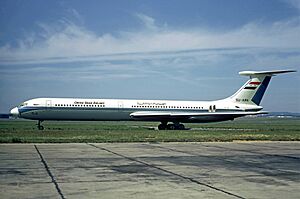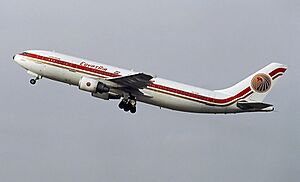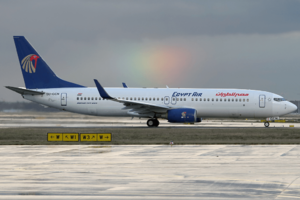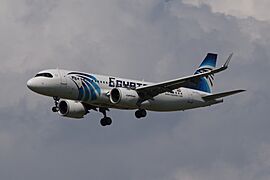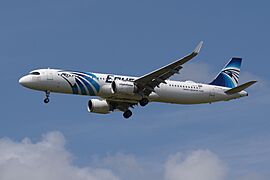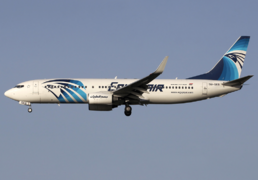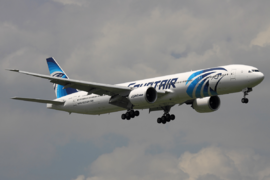Egyptair facts for kids
| Founded | 7 June 1932 |
|---|---|
| Commenced operations | July 1933 |
| Hubs | Cairo |
| Focus cities |
|
| Frequent-flyer program | Egyptair Plus |
| Alliance | Star Alliance |
| Subsidiaries |
|
| Fleet size | 65 |
| Destinations | 102 |
| Parent company | Egyptair Holding Company (Government of Egypt) |
| Headquarters | Egyptair Administrative Complex Cairo, Egypt |
| Key people | |
| Employees | 9,000 (December 2014) |
Egyptair is the national airline of Egypt. It is owned by the government and is based at Cairo International Airport, which is its main hub. Egyptair flies passengers and cargo to many places in Africa, Europe, Asia, and the Americas. It is also a member of Star Alliance, a big group of airlines that work together.
Contents
History of Egyptair
Starting out: Misr Airwork (1932–1949)
In 1931, Alan Muntz from Airwork visited Egypt and wanted to start a new airline there. It was called Misr Airwork. Misr means "Egypt" in Arabic. On December 31, 1931, the government gave the new company the only right to operate air transport in the country.
A part of Misr Airwork, called Misr Airlines, began on June 7, 1932. Its goal was to encourage young Egyptians to get involved in aviation. This made it the seventh airline in the world. Misr Airwork's main office was at Almaza Air Base in Heliopolis, Cairo.
The airline started flying in July 1933. It first connected Cairo with Alexandria and Mersa Matruh. They used de Havilland DH.84 Dragon planes. By August 1933, flights between Cairo and Alexandria happened twice a day. Later that year, flights from Cairo to Aswan started, stopping in Asyut and Luxor. In 1934, a flight from Cairo to Lydda, Haifa, and Gaza began.
By April 1939, the airline had several British planes. These included different types of de Havilland aircraft. In September 1939, the Egyptian government took over all the airline's routes. In 1940, flights to Beirut and Palestine began. After some plane accidents in 1945, flights stopped for a while but restarted in May 1946. In May 1949, the government bought all the company's shares and planes. The company then changed its name to Misrair SAE.
Misrair (1949–1957)
Misrair continued to fly the same routes. In 1951, they bought three Languedoc planes for longer flights. These planes replaced the Vikings on routes to Geneva, Khartoum, and Tehran.
On December 1, 1952, Misrair took over another Egyptian airline called Services Aériens Internationaux d'Égypte (SAIDE). Misrair only kept SAIDE's successful Cairo-Tunis route.
In early 1954, Misrair ordered three Vickers Viscount planes. In 1955, they carried over 77,000 passengers. The first two Viscounts arrived in December 1955 and started flying in March 1956. One Viscount was damaged during an air-raid in November 1956. In February 1957, Misrair was renamed United Arab Airlines.
United Arab Airlines (1957–1971)
After Egypt and Syria formed the United Arab Republic in 1958, Misrair became United Arab Airlines (UAA). Syrian Airways joined UAA in December 1958.
By March 1960, UAA had 579 employees and a fleet of various planes, including DC-3s, Vikings, and Viscounts. The first of three Comet 4C planes arrived in June 1960. These Comets started flying on international routes in July. By October 1960, Comets flew to places like London, Prague, and Jeddah.
In April 1961, UAA bought three DC-6 planes. Flights to Moscow began in June. A new flight to Karachi and Bombay started in November 1961. The service to Tokyo, which went through Bangkok and Hong Kong, began in May 1962.
Unfortunately, UAA had several plane crashes during this period. A DC-3 crashed near Heliopolis in May 1962, and a Comet crashed in Bangkok in July 1962. Another Comet crashed near Bombay in July 1963. These accidents caused the Tokyo route to be stopped for a while.
By March 1965, UAA used Comet 4Cs and Viscounts for flights across Europe, the Middle East, and North Africa. In June 1966, UAA ordered three Boeing 707-320C planes. The first Boeing 707 arrived in October 1968 and started flying the Cairo–London route.
In March 1970, UAA had 7,810 employees. Their fleet included An-24Bs, Boeing 707-366Cs, Comet 4Cs, and Il-18s. In May 1971, UAA announced they would get two Ilyushin Il-62 planes. These planes were used on European and Asian routes. On October 10, 1971, the airline's name was changed to Egyptair after Egypt changed its name to the Arab Republic of Egypt.
Egyptair (1971–Present)
Egyptair took over all of UAA's staff, planes, and responsibilities. On March 19, 1972, EgyptAir Flight 763, a Douglas DC-9-32, crashed in Yemen, killing all 30 people on board.
In July 1972, Egyptair ordered eight Tupolev Tu-154 planes and four Boeing 707-320Cs. The new Boeing 707s arrived in 1973. However, the three Il-62 planes were returned to Aeroflot in October 1973 because they were too expensive to operate and had technical problems. The first Tu-154 joined the fleet that same month.
The Yom Kippur War in 1973 caused the Tokyo service to be stopped, but it restarted on March 15, 1974. A new Tu-154 plane crashed during a training flight in July 1974, killing six crew members. After this, Egyptair asked the Soviets to take back their Tu-154 fleet and refund the money.
In January 1975, the government decided to buy new planes from Boeing instead of Douglas. By March, Egyptair ordered four Boeing 727-200s and six Boeing 737-200s. They also planned to sell their four Comets to help pay for the new Boeing planes.

New flights to Milan and Vienna started in 1976. In April 1976, a Boeing 737 was hijacked by three Palestinians, but an Egyptian team quickly took back control. The four Comets were sold in October 1976. In December 1976, EgyptAir Flight 864, a Boeing 707, crashed in Bangkok, killing everyone on board and some people on the ground.
In February 1977, Egyptair agreed to lease two Airbus A300B4 planes. The first A300 flight was to Karachi in June. Egyptair later bought these two leased A300B4 aircraft. In 1979, they ordered three more A300B4-200s.
By March 1980, Egyptair had two Airbus A300B4s, seven Boeing 707-320Cs, and seven Boeing 737-200s. In 1981, they ordered two more Airbus A300B4-200s. Overall, eight new Airbus A300B4s were added in the early 1980s. Three Boeing 767-200ERs joined the fleet in 1984, and two Boeing 767-300ERs in 1989. Sadly, one of these, "Tuthmosis III," crashed into the Atlantic Ocean on October 31, 1999, killing all 217 people on board.
Egyptair is owned by the government but operates like a private company. It does not get financial help from the Egyptian government.
In 2002, Egyptair changed its structure to become a holding company with several smaller companies under it. This happened when the Egyptian Minister of Civil Aviation was created, aiming to modernize airports and the airline.
Egyptair fully owns Egyptair Express and Air Sinai. It also has shares in Air Cairo (60%) and Smart Aviation Company (20%).
In May 2006, Egyptair started a regional airline called Egyptair Express. It began flying in 2007 with new Embraer E-170 jets. This airline connects Cairo with many cities in Egypt, like Sharm El Sheikh and Luxor. By June 2009, Egyptair Express had all 12 of its Embraer E-170 planes.
In early 2007, Egyptair worked with the Egyptian Ministry of Civil Aviation to create a new airline called Smart Aviation Company, based at Cairo Airport.
In 2009, Egyptair moved all its flights to the new Terminal 3 at Cairo International Airport. This new terminal greatly increased the airport's capacity. All Star Alliance airlines also moved to Terminal 3.
After the revolution in 2011, Egyptair faced big financial losses. The airline lost a lot of money due to higher fuel prices, the Egyptian currency losing value, and strikes.
In November 2012, Egyptair allowed its flight attendants to wear hijabs as part of their uniform.
In November 2015, Russian authorities temporarily stopped Egyptair from flying to Russia due to security concerns. This ban was lifted in April 2018.
Egyptair is one of the few airlines that does not serve alcoholic drinks on its flights.
As part of a reorganization, Egyptair Express officially merged with the main Egyptair airline on November 4, 2019. Plans for Egyptair Cargo and Egyptair Ground Services Company to merge were also in progress.
How Egyptair is Organized
Ownership and Structure
Egyptair is fully owned by the Government of Egypt. In 2002, the Egyptair Holding Company was created. It now includes several companies:
- Egyptair Airlines: This is the main airline.
- EgyptAir Cargo: This company focuses on cargo flights. It started in 2002.
- EgyptAir Express: This airline handles domestic and regional flights. It launched in 2007.
Other companies under Egyptair Holding Company are:
- Egyptair Maintenance & Engineering: This group maintains aircraft for Egyptair and other airlines.
- Egyptair Ground Services: They provide services to many airlines flying to Egypt.
- Egyptair In-flight Services: This handles services during flights.
- Egyptair Tourism & Duty Free Shops: This manages tourism and duty-free shops.
- Egyptair Medical Services: This provides medical services.
- Egyptair Supplementary Industries Company: This company was formed in 2006.
Other Companies Egyptair Works With
Egyptair also has shares in other companies:
- Air Cairo (60% owned)
- Smart Aviation Company (13.33% owned)
- Air Sinai (100% owned)
- Egypt Aero Management Service (50% owned)
- LSG Sky Chefs Catering Egypt (70% owned)
- CIAF-Leasing (20% owned)
Where Egyptair Flies
As of August 2022, Egyptair flies to 81 places in 56 countries.
Airline Groups
In October 2007, Egyptair was accepted as a future member of Star Alliance. It was the first airline from an Arab country and the second African airline to join this big group. On July 11, 2008, Egyptair officially became the 21st member of Star Alliance.
In October 2020, Egyptair and the government of Ghana agreed to create a Ghanaian national airline together.
Egyptair shares flights with many other airlines. This means you can book a flight with Egyptair, but part of your journey might be on another airline's plane. Some of these airlines include:
- Aegean Airlines
- Air Cairo
- Air Canada
- Air China
- Air India
- Asiana Airlines
- Austrian Airlines
- Avianca
- Brussels Airlines
- Ethiopian Airlines
- Etihad Airways
- Gulf Air
- Kenya Airways
- LOT Polish Airlines
- Lufthansa
- Royal Air Maroc
- Scandinavian Airlines
- Shenzhen Airlines
- Singapore Airlines
- South African Airways
- Swiss International Air Lines
- TAP Air Portugal
- Thai Airways International
- Turkish Airlines
- Ukraine International Airlines
- United Airlines
Flights to Qatar
Due to a diplomatic situation in 2017, Egyptair stopped its flights to Doha, Qatar. However, in 2021, after an agreement was reached, Egyptair restarted flights to Doha.
Egyptair's Planes (Fleet)
Current Planes
As of July 2025, Egyptair uses these planes:
| Aircraft | In service | Orders | Passengers | Notes | |||
|---|---|---|---|---|---|---|---|
| C | Y | Total | |||||
| Airbus A320neo | 8 | — | 16 | 126 | 142 | ||
| Airbus A321neo | 7 | — | 16 | 166 | 182 | ||
| Airbus A330-200 | 4 | — | 24 | 244 | 268 | 2 to be converted to freighter. | |
| Airbus A330-300 | 4 | — | 36 | 265 | 301 | ||
| Airbus A350-900 | — | 16 | TBA | Deliveries from 2025. | |||
| Boeing 737-800 | 29 | — | 24 | 120 | 144 | ||
| 16 | 138 | 154 | |||||
| Boeing 737 MAX 8 | — | 18 | TBA | Deliveries from 2025. | |||
| Boeing 777-300ER | 5 | — | 49 | 297 | 346 | ||
| Boeing 787-9 | 8 | — | 30 | 279 | 309 | ||
| Total | 65 | 34 | |||||
Gallery
How the Fleet Grew
In June 1995, Egyptair ordered three Airbus A340s. They also bought three Boeing 777-200s to replace older planes.
In early 2003, the airline ordered seven Airbus A330-200 aircraft. The first Airbus A330-300 joined the fleet in August 2010.
Egyptair's relationship with Boeing began in 1968 with the delivery of a Boeing 707. In August 2005, six Boeing 737-800s were acquired. The first 346-seater Boeing 777-300ER was delivered in March 2010.
In June 2011, Boeing delivered its 50th aircraft to Egyptair, which was a 737-800. In October 2016, Egyptair placed a firm order for eight more Boeing 737-800s.
In late 2017, the airline planned to order six Boeing 787-9s and 15 Airbus A320neos. During the 2019 Dubai Airshow, the order for 15 Airbus A320neos was changed to seven A321neos and eight A320neos. Also, two more Boeing 787-9s were ordered.
Past Planes (Historical Fleet)
Egyptair has used many different types of planes over the years. Here are some of them:
| Aircraft | Introduced | Retired | Notes |
|---|---|---|---|
| Airbus A220-300 | 2019 | 2024 | |
| Airbus A300B4 | 1977 | 1998 | |
| Airbus A300-600 | 1988 | 2009 | |
| Airbus A321-200 | 1997 | 2018 | |
| Airbus A340-200 | 1996 | 2015 | |
| Airbus A340-300 | 1995 | 1997 | |
| ATR 42-500 | 2003 | 2003 | |
| Boeing 737-500 | 1997 | 2015 | |
| Boeing 747-100 | 1983 | 1984 | |
| Boeing 747-200 | 1984 | 1989 | |
| Boeing 747-300 | 1988 | 2005 | |
| Boeing 767-200ER | 1984 | 1997 | |
| Boeing 767-300ER | 1989 | 2001 | |
| Boeing 777-200ER | 1997 | 2018 | |
| Douglas DC-8-20 | 1978 | 1979 | |
| Douglas DC-8-30 | 1978 | 1979 | |
| Douglas DC-8-62 | 1985 | 1989 | |
| Ilyushin Il-62 | 1971 | Unknown | |
| Lockheed L-1011 TriStar | 1989 | 1990 | |
| McDonnell Douglas DC-9-30 | 1971 | 1973 | |
| Tupolev Tu-154 | 1973 | 1974 |
Incidents and Accidents
Aviation safety is very important. Here are some notable incidents involving Egyptair and its earlier names:
- On December 22, 1951, a Misrair plane crashed in Iran, killing all 20 people on board.
- On July 30, 1952, a Misrair plane was badly damaged during landing in Cairo after an engine fire.
- On December 15, 1953, a Misrair plane crashed shortly after takeoff from Cairo, killing all six on board.
- On November 1, 1956, a Misrair plane was damaged while parked at Almaza Airport during an air-raid.
- On September 29, 1960, a United Arab Airlines plane crashed into the Mediterranean Sea, killing all 21 on board.
- On July 19, 1962, United Arab Airlines Flight 869 crashed into a mountain in Thailand, killing all 26 people on board.
- On July 28, 1963, United Arab Airlines Flight 869 crashed into the sea near Bombay, India, killing all 63 people on board.
- On March 18, 1966, United Arab Airlines Flight 749 crashed while landing in Cairo, killing all 30 people on board.
- On March 20, 1969, a United Arab Airlines plane crashed while landing at Aswan Airport. 100 of the 105 people on board died.
- On March 19, 1972, EgyptAir Flight 763 crashed into a mountain in Yemen, killing all 30 people on board.
- On January 29, 1973, EgyptAir Flight 741 crashed near Nicosia, killing all 37 people on board.
- On July 10, 1974, a Tupolev Tu-154 on a training flight crashed near Cairo Airport, killing six crew members.
- On December 25, 1976, EgyptAir Flight 864 crashed into a factory in Bangkok, Thailand. All 52 people on board and 19 people on the ground were killed.
- On October 17, 1982, Egyptair Flight 771 crashed on landing in Geneva, Switzerland. No one died, but the plane was too damaged to be repaired.
- On October 10, 1985, EgyptAir Flight 2843 was intercepted by US warplanes and forced to land in Italy.
- On November 23, 1985, EgyptAir Flight 648 was hijacked to Malta. During a rescue attempt, many people were killed or injured.
- On September 21, 1987, an Airbus A300 crashed at Luxor International Airport during a training flight, killing all five crew members.
- On October 31, 1999, EgyptAir Flight 990, a Boeing 767, crashed into the Atlantic Ocean, killing all 217 people on board.
- On May 7, 2002, EgyptAir Flight 843, a Boeing 737-500, crashed in Tunisia during bad weather, killing 15 of 64 people.
- On July 29, 2011, EgyptAir Flight 667, a Boeing 777, caught fire in the cockpit at Cairo International Airport. Everyone escaped, but the plane was too damaged to be repaired.
- On March 29, 2016, EgyptAir Flight 181, an Airbus A320, was hijacked. All hostages were released safely, and the hijacker surrendered.
- On May 19, 2016, EgyptAir Flight 804, an Airbus A320, crashed into the Mediterranean Sea, killing all 66 people on board. Investigations have suggested different causes for the crash.
See also
 In Spanish: EgyptAir para niños
In Spanish: EgyptAir para niños
- Transport in Egypt



